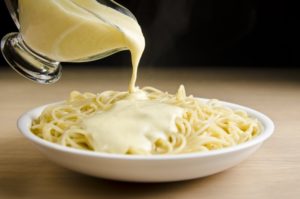
When you undergo a professional teeth whitening treatment, it is important that you take steps to prevent your teeth from incurring new stains. After all, your treatment will not stop your teeth from absorbing pigments. How can you keep your smile as bright as possible for as long as possible? One thing you can do is adjust your diet. This article talks about some foods that whiten teeth, as well as some that you should avoid.
The White Diet
For the first 24 – 48 hours after an in-office professional whitening service (as well as throughout a longer at-home whitening treatment), your teeth may be extra sensitive, and they may also be more likely to incur new stains. During this crucial window, you should stick to what is commonly called “the white diet.” Basically, you should avoid any foods that could stain a white t-shirt, but if a food is white or clear in color, it is probably safe to eat. Here are some foods and beverages that fit into the white diet:
- Potatoes
- Rice
- Milk
- Sprite/7Up
- White wine
- White cheeses
- Bananas
- Chicken
- Turkey
- Pasta with white sauce
After the Initial Post-Treatment Period
A few days after you complete your whitening treatment, you can start to enjoy a wider variety of foods. However, you should still limit your intake of anything that could stain your teeth. For example, you should be careful not to overconsume coffee, tea, or red wine. If you do indulge in such beverages, drinking them through a straw can minimize their contact with your teeth and therefore minimize their potential to cause discoloration.
Here are some foods that may contribute to maintaining your white smile:
- Crunchy vegetables. Raw celery, carrots, and similarly crunchy veggies can help to clean your teeth and encourage saliva production, which can help to prevent new surface stains.
- Dairy products. Not only do dairy products contain calcium, which is wonderful for teeth, but they have other benefits as well. For example, some researchers believe that proteins in yogurt can bind to teeth and protect them from acids.
A Warning Against Acids
You may have heard about people using strawberries to whiten their teeth. That is not a good idea. The malic acid in the strawberries might make your teeth look brighter, but it could also damage your smile if your teeth are exposed to it for too long. Something similar is true of other acidic fruits, like pineapples and oranges. You do not have to avoid such fruits altogether, but you should never use them to make an at-home whitening paste. The best way to perform touch-ups after your whitening treatment is to visit your dentist and ask for a high-quality at-home whitening kit.
Your dietary choices have a big impact on your smile’s health and appearance. Following the advice in this article may help your teeth to stay strong, bright, and beautiful.
Meet the Practice
Gillis Dental features a team of experienced cosmetic dentists and specialists, all of whom want to help patients enjoy healthy, attractive smiles. Professional teeth whitening kits are among the many services -they offer. To learn more about how you can fight dental stains, contact our office at 781-202-6357.
